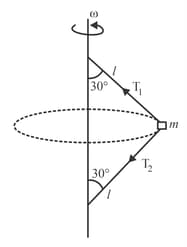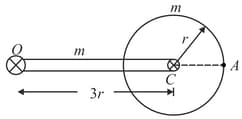Kinetic Energy of a Rotating Body
Kinetic Energy of a Rotating Body: Overview
This topic covers concepts, such as, Angular Velocity,Translational and Angular Velocities,Energy in Rotational Motion etc.
Important Questions on Kinetic Energy of a Rotating Body
Angular position of a line of a disc of radius is given by . The average angular speed (in ) between is:
. A coin placed on a revolving disc, with its centre at a distance offrom the axis of rotation just slips off when the speed of the revolving disc exceeds. What should be the maximum angular speed of the disc, so that when the coin is at a distance of from the axis of rotation, it does not slip?
A circular plate is rotating in horizontal plane, about an axis passing through its centre and perpendicular to the plate, with an angular velocity . A person sits at the centre having two dumbbells in his hands. When he stretched out his hands, the moment of inertia of the system becomes triple. If be the initial Kinetic energy of the system, then final Kinetic energy will be . The value of is
the angular speed of earth around the Sun is
A body is rotating with kinetic energy . If angular velocity of body is increased to three times of initial angular velocity, the kinetic energy becomes . Find .
Assertion Fan spins even after switch is off
Reason Fan in rotation has rotational inertia
A solid sphere having mass and radiusrolls down an inclined plane. Then its kinetic energy is
When a ceiling fan is switched off, its angular velocity reduces to of its initial value while it makes rotations. If angular retardation of the
fan is uniform, then how many more rotations will it make before coming to rest?
A particle of mass is whirled in horizontal circle with the help of two threads of length each as shown in figure. Angular velocity equals , then

A disc rotates freely with rotational kinetic energy about a normal axis through centre. A ring having the same radius but double the mass of disc is now, gently placed on the disc. The new rotational kinetic energy of the system would be
Two rigid bodies and may undergo pure rotation about axis of rotation about which moment of inertia and . Initially they are in rest condition and acted by constant torque about axis of rotation which is in ratio then power developed after time for and will be in the ratio:
A uniform rod of mass and length is free to rotate about a horizontal axis through . A disc of mass , radius , is free to rotate about another horizontal axis fixed to other end of the rod (say ). . The system is released from rest when rod is horizontal. What is the velocity of particle at (in ) when rod becomes vertical?

A coil having magnetic moment is placed in a vertical plane & is free to rotate about its horizontal axis coincides with its diameter. A uniform magnetic field of in the horizontal direction exists such that initially the axis of the coil is in the direction of the field. The coil rotates through an angle of under the influence of magnetic field. The moment of inertia of coil is . What will be its angular speed?
A uniform solid sphere rolls on a horizontal surface with a linear speed of . It then rolls up a plane inclined at to horizontal. What is the height up to which the sphere rises? Assume that the surface is frictionless. Also calculate the distance travelled by the sphere on the inclined plane?

In figure, and . A rigid uniform sphere starts from the point from rest and rolls down the track without slipping and reaches the horizontal right-hand end . What is the distance to the right of the point at which the sphere strikes the horizontal base line?

The mass of a hoop of radius is . It rolls along a horizontal floor so that its centre of mass has a speed of . What is the work done to stop it?
The earth has a mass of and a radius . Calculate the amount of work done if its rotation were to be slowed down so that the duration of the day becomes hours instead of hours.
To a horizontal axle , a sphere of mass and radius is attached as shown in the figure. The sphere can roll without sliding over the frictionless horizontal plane. What is the kinetic energy of the sphere, if the centre of the sphere moves with a velocity along a circle of radius ?

A hollow sphere and a solid sphere of the same dimensions rotate about the same axis with the same angular velocity. Which has greater kinetic energy ?
